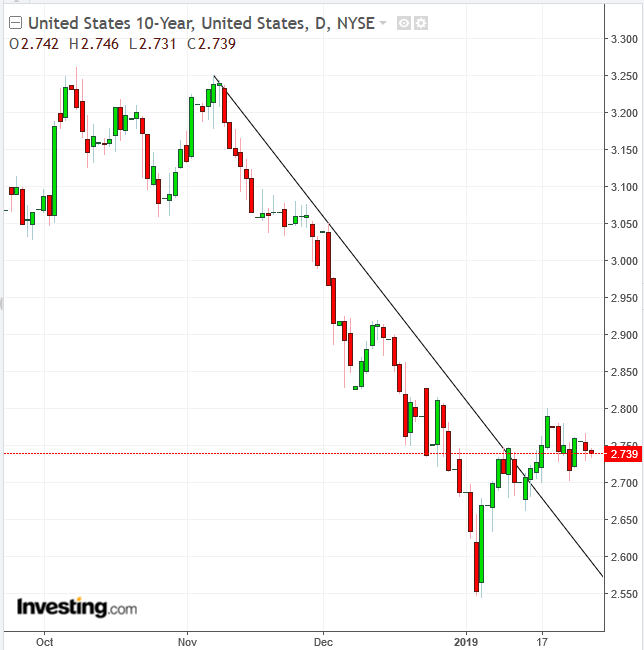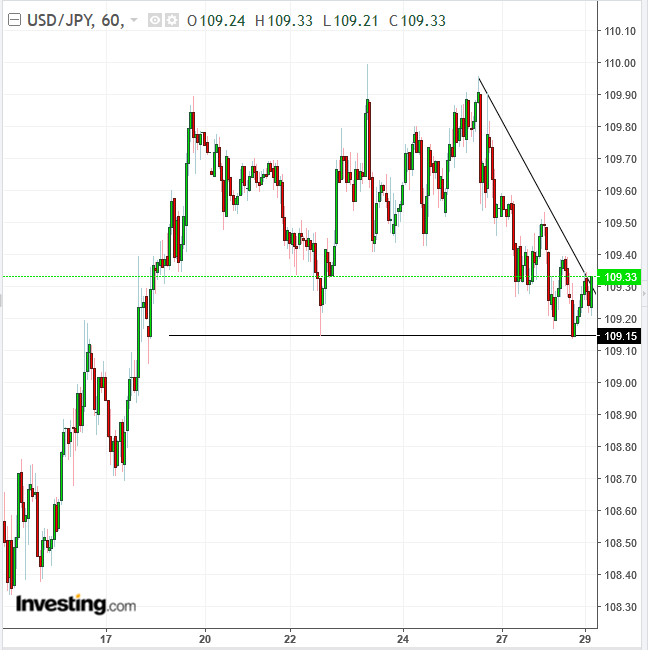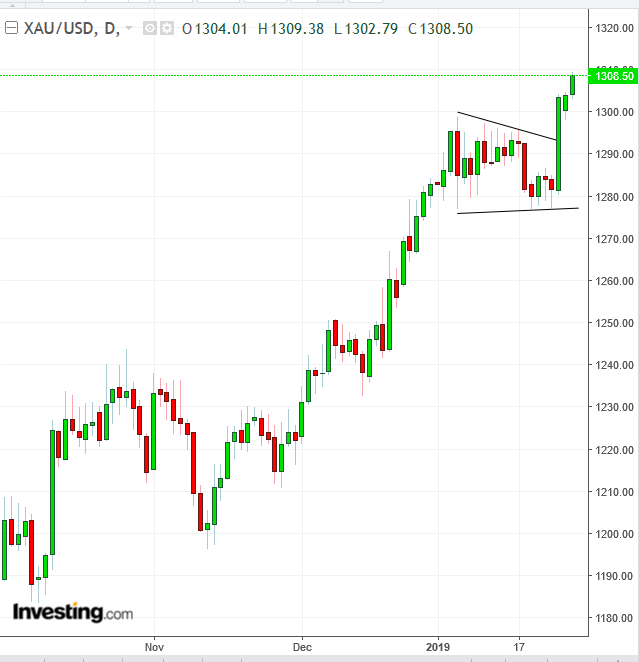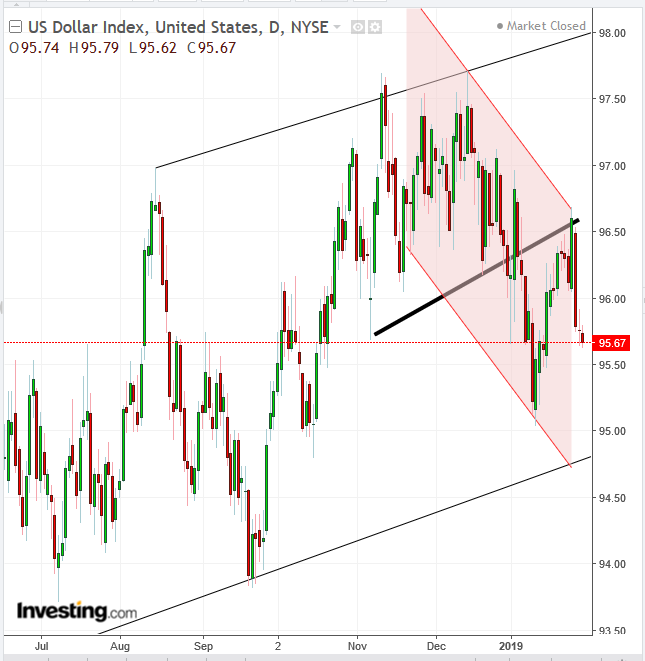- Equity markets remain choppy after earnings worries rile U.S. markets
- Safe-haven assets post mixed picture; gold climbs
- Dollar wavers ahead of Fed meeting
- Oil edges higher amid U.S. sanctions against Venezuela
Key Events
European shares on the STOXX 600 and futures on the S&P 500, Dow and NASDAQ 100 firmed up this morning, though U.S. contracts struggled to cross neutral levels following a choppy Asian session. The short-term pattern seems to suggest that investor sentiment shifts overnight to improve partially at the start of the European session. Safe havens also provided a mixed picture, with 10-year Treasury yields initially paring losses but later slipping lower, the yen wavering and gold gaining ground.
Perhaps hopes around Wednesday's U.S.-China trade talks are offsetting, at least for now, mounting worries on global economic growth. This latter element was underscored by a selloff in U.S. equities yesterday, after bellwether Caterpillar (NYSE:CAT) blamed its disappointing quarterly results on weaker Chinese demand, and NVIDIA (NASDAQ:NVDA) cut its revenue guidance to $2.2 billion from $3.7 billion on “deteriorating macroeconomic conditions, particularly in China,” exacerbating the soft-guidance theme that upset markets at the end of 2018. After it roiled markets by cutting its forward outlook last quarter, Apple (NASDAQ:AAPL) is sure to monopolize investor attention with its fresh earnings report, which comes up after market close today.

Meanwhile, the yield on 10-year bonds rebounded but closed lower for a second day, as traders tried to determine whether the new-year equity bounce marks just a correction or a reversal.

The yen was also struggling, between an upward push since Friday, from below the 110.00 level—a resistance since mid December—and the bottoming out pattern. In the USD/JPY chart, the dollar is struggling against its downtrend line since last Friday, thereby topping out.

Gold was targeting the $1,309 level, extending the upside breakout of a continuation pennant pattern to reach the highest level since May.

It’s noteworthy that the yellow metal is most likely benefiting from a weakening dollar. After topping out in the short term, the greenback was on a collision course with the bottom of its medium-term trend, represented by the bottom of an ascending channel.
Why would the dollar fall ahead of a Fed meeting, which should shed more light on policymakers' recent change of heart on a faster pace interest rates tightening? Perhaps, investors think the Fed's about-face is not priced in, considering the recent selloff. Another possible driver is foreign demand for Treasurys, as global investors position themselves more cautiously amid growing fears of an impending recession. However, the dollar may have just slid lower on the technicals, as described above. Besides, it was rebounding slightly by the late European morning session.

Meanwhile, the buck is also falling against the renminbi. Thus could come as a reaction to the U.S. announcing criminal charges against Chinese telecoms giant Huawei (SZ:002502), or, more probably, on the technicals, as the price retests yesterday’s low.
In the earlier Asian session, an indecisive market oscillated between growth concerns and trade hopes.
Japan’s Nikkei rebounded from an intraday loss of over 1 percent, averting a two-day slide after it underperformed its peers yesterday.
South Korea’s KOSPI outperformed as it gained 0.28 percent, boosted by a rush to IT stocks after Samsung (KS:005930) posted robust earnings. The Korean won rose against the dollar, as much of the buying on the index was fueled by foreign investors.
China’s Shanghai Composite edged 0.1 percent lower and Hong Kong’s Hang Seng declined 0.16 percent, but it was Australia’s S&P/ASX 200 that lagged the most, dropping 0.53 percent on Chinese risk. The index was probably weighed down by U.S. charges against Huawei, which may have caught Chinese trade representatives—heading to Washington for a key round of trade talks—off-guard yesterday. We have often shown how Australian markets are more sensitive to Chinese headwinds than Chinese markets themselves. The country's economy in fact relies heavily on demand from China, which represents its biggest trading partner.
In other news, WTI crude stabilized even as the Trump administration hit Venezuela’s state-owned oil firm PDVSA with sanctions. Technically, the price of oil is struggling between bulls, who are attempting to bottom out the contract by pushing prices above $55 with a trend “revolution”, and bears, who are attempting to top it out, above the $50 levels. By late European morning, the price was seen more steadily in green territory.
Up Ahead
- Chinese President Xi Jinping’s top economic adviser, Vice Premier Liu He, will meet with U.S. Trade Representative Robert Lighthizer and Treasury Secretary Steven Mnuchin on Wednesday and Thursday.
- The U.K. Parliament votes on amendments to Theresa May’s Brexit bill on Tuesday. The EU Parliament debates Brexit on Wednesday.
- Also on Wednesday, Fed Chairman Jerome Powell holds a news conference after the FOMC rate decision.
- Apple is expected to report earnings on Tuesday after market, with a $4.17 EPS forecast, after posting $3.89 for the same quarter last year.
- Microsoft (NASDAQ:MSFT) is scheduled to release earnings results on Wednesday after market, with upbeat predictions of $1.09 EPS, up from last year’s $0.96 EPS for the corresponding quarter.
- Facebook (NASDAQ:FB) is due to report corporate results on Wednesday after market, with a $2.17 EPS expectations, from the $2.2 the same quarter last year. Multiple factors are currently weighing on the media giant's price recovery outlook.
- Qualcomm (NASDAQ:QCOM) will release earnings on Wednesday after market, with a $0.91 EPS prediction, from last year’s $0.85.
- Tesla (NASDAQ:TSLA) will publish earnings on Wednesday after market with a $1 EPS forecast, from $-3.84 the same quarter last year.
Market Moves
Stocks
- The MSCI All-Country World Index dropped by less than 0.05 percent.
- The MSCI Emerging Market Index slid 0.1 percent.
Currencies
- The euro advanced 0.1 percent to $1.1441, the strongest in more than two weeks.
- The Japanese yen gained 0.1 percent to 109.23 per dollar, the strongest in almost two weeks.
- The British pound dropped 0.1 percent to $1.3146.
- The MSCI Emerging Markets Currency Index climbed less than 0.05 percent, hitting the highest in more than seven months with its fifth straight advance.
Bonds
- Germany’s 10-year yield decreased less than one basis point to 0.20 percent.
- Britain’s 10-year yield slid less than one basis point to 1.261 percent, the lowest in two weeks.
- The spread of Italy’s 10-year bonds over Germany’s rose one basis point to 2.4676 percentage points.
Commodities
- The Bloomberg Commodity Index climbed 0.1 percent.
- West Texas Intermediate crude increased 0.1 percent to $52.06 a barrel.
- LME copper gained 0.3 percent to $6,021.00 per metric ton.
- Gold advanced 0.3 percent to $1,307.85 an ounce, the highest in more than eight months.
